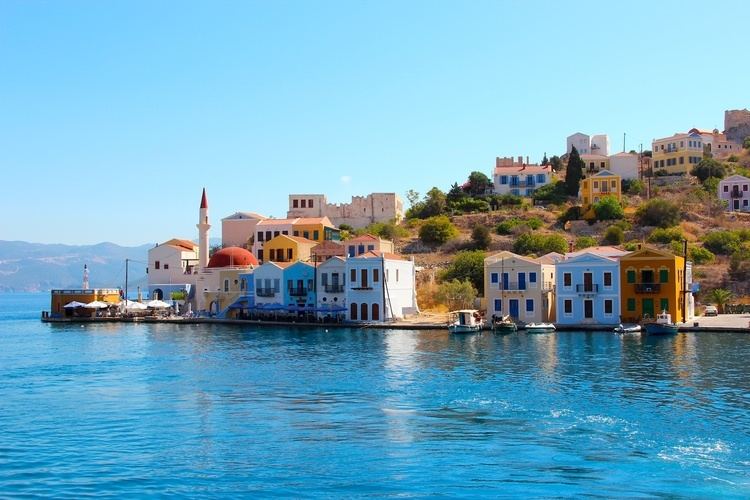Elevation 0- 700 m (−2,300 ft) Postal code 07x xx Area 2,231 km² | Region Mediterranean Time zone EET (UTC+2) Licence plate 07 Local time Saturday 4:38 PM Area code 242 | |
 | ||
Weather 14°C, Wind E at 16 km/h, 79% Humidity Points of interest Çınarlar Beach By Orcholiday, Kral Mezarı, Strongyli Megistis | ||
Kaş (pronounced 'Kash') is a small fishing, diving, yachting and tourist town, and a district of Antalya Province of Turkey, 168 km west of the city of Antalya. As a tourist resort, it is relatively unspoilt.
Contents
- Map of KaC59F Andifli Mahallesi 07580 KaC59F2FAntalya Turkey
- Geography
- History
- Tourism
- Demographics
- Places of interest
- References
Map of Ka%C5%9F, Andifli Mahallesi, 07580 Ka%C5%9F%2FAntalya, Turkey
Geography
The town of Kaş is on a hill running down to the Turquoise Coast of southwestern Turkey. The district has a typical Mediterranean climate of hot, dry summers and warm, wet winters, which allows the growth of oranges, lemons and bananas. The lowland areas are also planted with cut flowers and a variety of fruits and vegetables, many are grown all year round under glass. The hillsides produce honey, and almonds, while at high altitudes there are extensive pine forests. The weather is drier at high altitudes. Although agriculture is still important, tourism is the main source of income in the district, which has many hotels and guest houses.
About 6 km (4 mi) offshore from Kaş is the Greek islet of Kastelórizo (in Turkish Meis Adası) served by a Turkish ferry daily with the option of same day returns.
History
Although the Teke peninsula has been occupied since the stone age it seems Kaş was founded by the Lycians, and its name in Lycian language was Habesos or Habesa. It was a member of the Lycian League, and its importance during this time is confirmed by the presence of one of the richest Lycian necropoleis.
In the Hellenistic period and under the Roman Empire it served as the port of Phellus. For information on its history at that time and on its archaeological remains, see the article on Antiphellus, the name by which it was known at that time.
The town suffered because of Arab incursions, then was annexed (under the name of Andifli) to the Anatolian Sultanate of Rum, led by the Seljuks. After the demise of the Seljuks, it came under the Ottomans.
In 1923, because of the Exchange of populations between Greece and Turkey after the Greco-Turkish War, the majority of the population, which was of Greek origin, left the town for Greece. Abandoned Greek houses can still be seen at Kaş.
In the early 1990s tourism started booming in Kaş, with visitors mainly from the UK and Germany. This growth of tourism brought an explosion in apartment building (often without license), which is seriously threatening the landscape and the environment. Particularly affected is the beautiful Çukurbağ Peninsula, west of the town, which now has luxury hotels built on it.
Tourism
The tourist industry is centred on the pleasant town of Kaş, but many other coastal towns and villages in the district have plenty of accommodation for visitors including Kalkan and Gelemiş. The district can be reached from both Antalya and Dalaman airports.
Kaş itself is a quiet pleasant town with its blue sea and narrow streets scented with jasmine flowers. There are plenty of little guest houses, quiet cafes serving home cooking, or small bars to relax after a day's scuba diving. Kaş has an annual arts festival, jazz concerts in the Hellenistic theatre and the Kiln Under the Sea arts collective have held underwater ceramics exhibitions here.
Kaş is one of the leading spots for scuba diving in Turkey. Its ideal for beginners as well as advanced divers. There are more than 15 dive centers and diving schools, mostly located at the local port. They offer guided diving trips to the 50 dive spots in the vicinity. Diving in Kaş offers beautiful array of fish and other sea creatures like octopus and sea turtles. Besides the biological diversity, Kaş offers a vast variety of underwater cultural heritage. Among various wreck sites, six artificial wrecks are worth visiting. These wrecks are submerged to create artificial reefs and touristic diving spots. There are two historically important wreck sites, an airplane from World War II and a cargo ship from 1950's sink near the small islands in the extremities of Kaş. One last important diving spot is so called "Kaş Archaeopark Site" that is an experimental archaeology project conducted by Underwater Research Society (Sualtı Araştırmaları Derneği-SAD) in 2006. In this scientific project, an interpretative reconstruction of the Uluburun wreck and its cargo is placed underwater.
Outdoor sport activities attract the more adventurous visitors of Kas, especially small grup holidays from Europe and independent travellers. To name a few popular adventures:
On Fridays, Greek visitors from nearby islands such as Kastelorizo visit the markets of Kaş.
Demographics
According to the 2010 census, the town has 7,041 residents and the whole district (together with the villages) has 53,135 inhabitants. Kaş has 5 municipalities (Gömbe, Kalkan, Kınık, Ova and Yeşilköy) and 48 villages.
The population of inhabited places is as follows according to 2007 census (Municipalities are shown in bold)
